Casinos tend to be pretty hush hush about their payback percentage. Some casinos are required to report certain data, but on a machine by machine basis that data isn’t traditionally known. And many casinos aren’t required to report data publicly at all, even in certain commercial markets.
But occasionally, information can become available through a variety of normal business operations, which can help players get a sense of what’s going on there.
Periodically casinos will install new machines, and move around old ones, as they keep their slot floor up to date. The process usually takes a bit, as there can be dozens of machines on a casino floor, each of which need to be set up, configured and verified.
But that also means potential information for you as a player. Often times taped to each machine, in plain sight of everyone, is a paper with important information that needs to be verified for the machine. Some of it’s mundane – the game’s name, bet increments, denomination and so forth.
But in other cases it can be more interesting information such as the game’s payback percentage, or what percentage is contributed to the progressives, which are among the game’s configuration settings.
I was able to see just this at a casino I visited recently, with the information taped onto the paper. I did see a few things based on what was in that area being reworked:
- They were following the minimums required by their local regulations. This to me certainly isn’t surprising, but given the various urban legends such as casinos hacking machines or setting paybacks lower than they’re allowed, seeing this information on display publicly can help people feel a bit more confident.
- Not all penny games are alike, payback wise. Most of the newer games were set within a pretty consistent range, which would make sense, but they were also moving around some older games that were set higher. Some old Bally machines were set 2-3 percent higher, and a few Aristocrat machines that were older were set 5 percent higher. There are a couple of potential reasons for this:
- They set older machines higher to encourage more play. This to me seems unlikely unless they’re purposefully advertising a looser game. Meanwhile, some believe casinos set new games looser – this was a great example of that simply not being the case.
- Older games can’t be set as low as far as their paybacks are concerned. I think this is the more likely culprit, and relates to what I wrote recently about how market forces pushed paybacks down over time.
- Paybacks fell within a range. Most of the time games are built with payback settings roughly 2 percent apart; as such if a casino wants pennies to pay around 88 percent, they could be picking settings within an 87-89 percent range, because that’s what each game can offer. So even within the newer games there was a roughly 2 percentage point swing from the lowest set one to the highest set one.
- You can see the impact of the progressives. The more money being banked into the progressives, the more the progressives weigh into the payback of the machine. Just like a royal flush has a meaningful impact on the overall payback of a Video Poker machine, progressives do for a game, especially when they carry a lot of the weight. These papers can also indicate how important the progressives are for a given game being installed on the casino floor.
The machines were not roped off, and you could walk right up and view these papers, which gave a bit of insight as to what to expect at this particular casino. If you happen across this sort of scenario, this information could help you decide that the older machines at this casino are a better bet, for instance, especially if you’re playing there enough over time, to get into that level of play where it will be statistically meaningful.









I saw this same paper on a few raking bacon machines that were new at my local. I didn’t know I should of paid more attention to them. I will in the future. Thanks Josh for all the good info you put out.